If you’ve been dreaming of a gluten-free pizza crust that’s chewy on the inside, crisp on the edges, and full of real pizzeria flavor, this is the recipe to make. Whether you bake it in the oven or just toss it on the grill, this recipe makes pizza night easy and delicious for everyone at the table.
This post may contain affiliate links. Please read our Disclosure Policy.
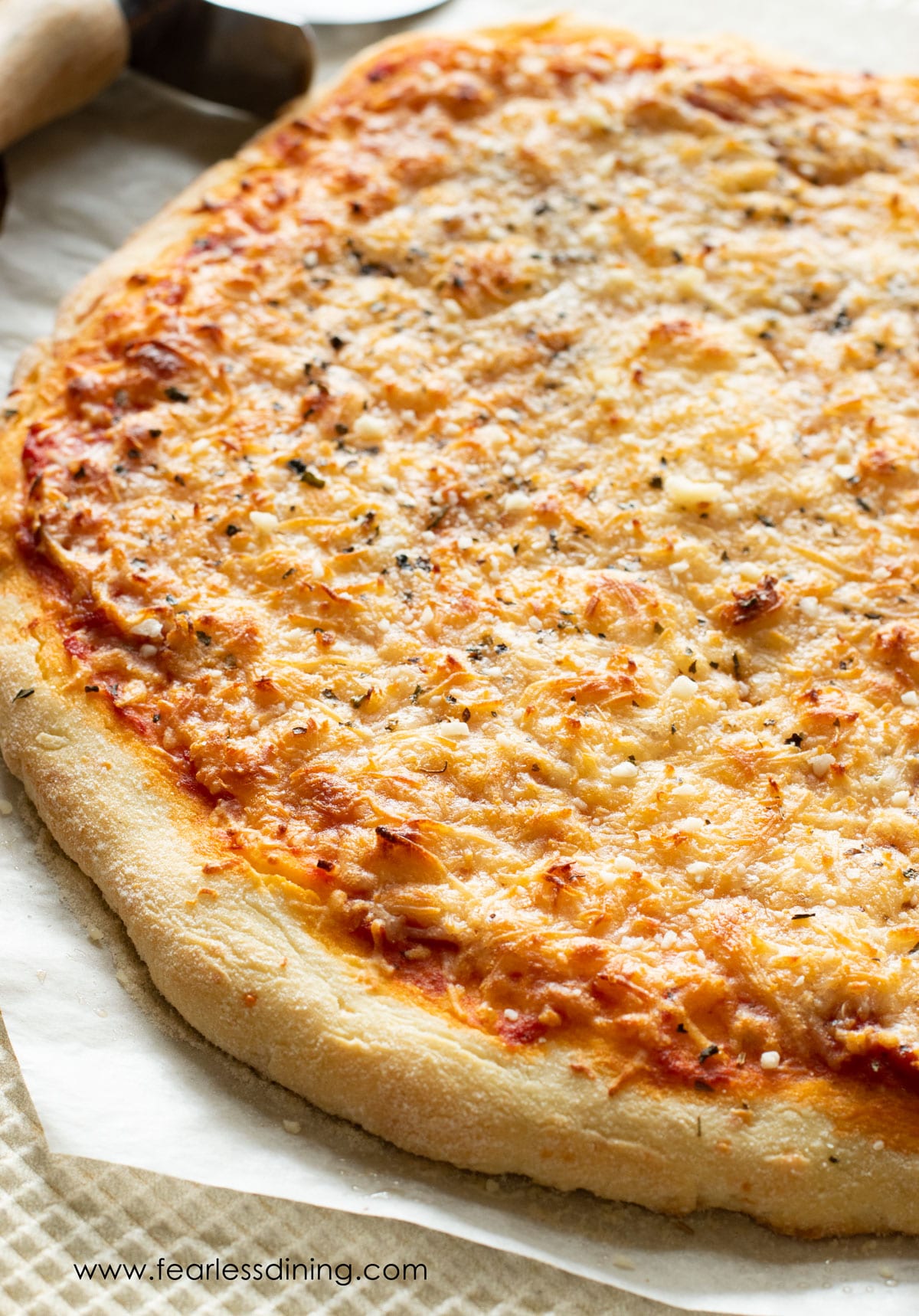
Do you love pizza nights? When we went gluten-free, pizza was the one thing my kids missed most. Making homemade gluten-free pizza dough was very different using gluten-free flour, and it tasted different, which my kids definitely noticed. After some trial and error, I created a gluten-free pizza dough recipe that our whole family loves, even my picky eater. I hope your family loves this crust too!
I’ve tested and refined this recipe over the years. When we first went gluten-free, you couldn’t buy any gluten-free foods in stores. You can make my recipe with just a few simple ingredients, and you can be confident that it will work. This recipe is reliable and tastes delicious.
Making gluten-free pizza with my easy gluten-free pizza base recipe is easy. This crust turns out fluffy, chewy, and light, and it can be used to make either a thin or thick crust!
Want more gluten-free pizza night ideas? Try these reader favorites:
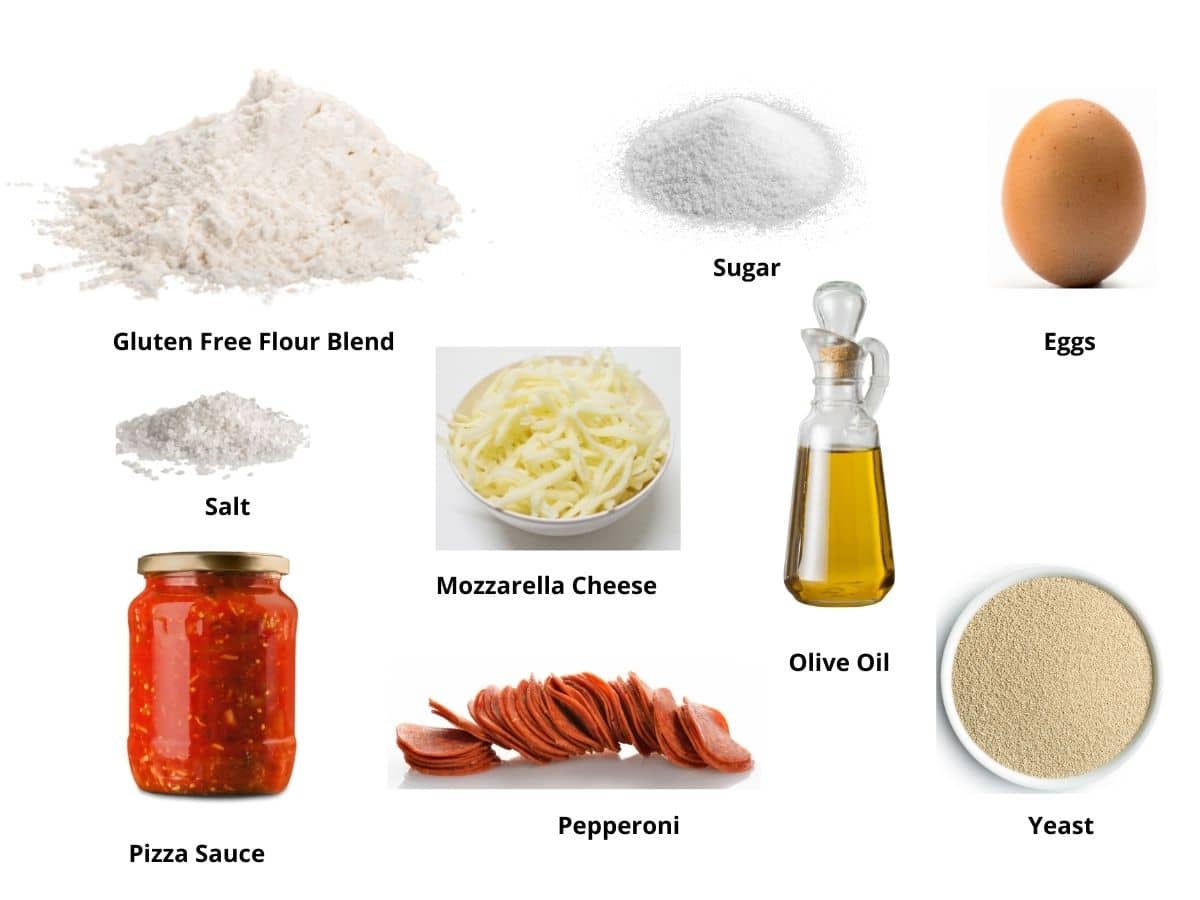
Ingredient Notes and Easy Allergen Swaps:
For the full list of ingredients and amounts, please go to the recipe card below. If you’re new to working with gluten-free yeast dough, don’t worry, I’ve included tips and flour blend notes to help you get great results.
- Gluten-Free Flour Blend – I tested Cup4Cup for this recipe because it makes this pizza dough rise well. I also tested Bob’s Red Mill All-Purpose Gluten-Free Flour Blend (in the red bag!) Reader Tested Blends: Better Batter Artisanal Blend and Pillsbury Gluten-Free Flour Blend. * I do not recommend using King Arthur Measure for Measure or Bob’s 1:1 (light blue bag), as these two do not work well with yeast recipes. Refer to the Swaps section above for a yeast-free alternative if you prefer using 1:1 blends.
- Xanthan Gum – If your gluten-free flour blend doesn’t contain a binder like xanthan gum or guar gum, please add one teaspoon.
- Yeast – I used active dry yeast, but rapid yeast also works in this recipe. Double-check that the brand you use is gluten free. Red Star Platinum is NOT gluten-free!
- Eggs – Size large. Eggs help with binding and the perfect crust texture.
- Olive Oil – Olive oil helps soften the dough and gives the crust a golden, flavorful finish.
- Sauce – Be sure the sauce you use is gluten-free. I will share some great sauce recommendations below. If you prefer to use store-bought pizza sauce, several delicious gluten-free pizza sauce brands are available. I like Rao’s, Trader Joe’s, and Mezetta best.
- Cheese – Use regular mozzarella and parmesan or use dairy-free alternatives.
- Make it dairy-free: Use vegan cheese like Daiya or VioLife.
- If you are yeast intolerant, try my Gluten-Free Pizza Crust with No Yeast. You can make this crust quickly because it doesn’t need extra time to rise!
- Make it gum-free: Use my DIY Gluten-Free All-Purpose Flour Blend. It is gum-free, and Mr. Fearless Dining said it added a more realistic chewiness to this pizza crust. Note that if you use my flour blend, you will need to add 3-4 additional tablespoons of water and 1 teaspoon of psyllium husk powder to the dough.

A Note From My Kitchen
If this is your first time making gluten-free pizza dough from scratch, don’t worry! The dough will feel a little different than wheat dough, but I’ll walk you through every step so you get great results. Don’t worry if the dough feels a little softer than non-gluten-free pizza dough. This is normal. If your dough isn’t workable, add more flour 1 TBSP at a time until you can work the dough. Every gluten-free flour blend is slightly different, so making small adjustments to the moisture is often necessary.
How to Make Gluten-Free Pizza Dough (Step-By-Step)
Are you ready to give this easy pizza crust recipe a try? First, let’s walk through the steps to make the gluten-free pizza base.
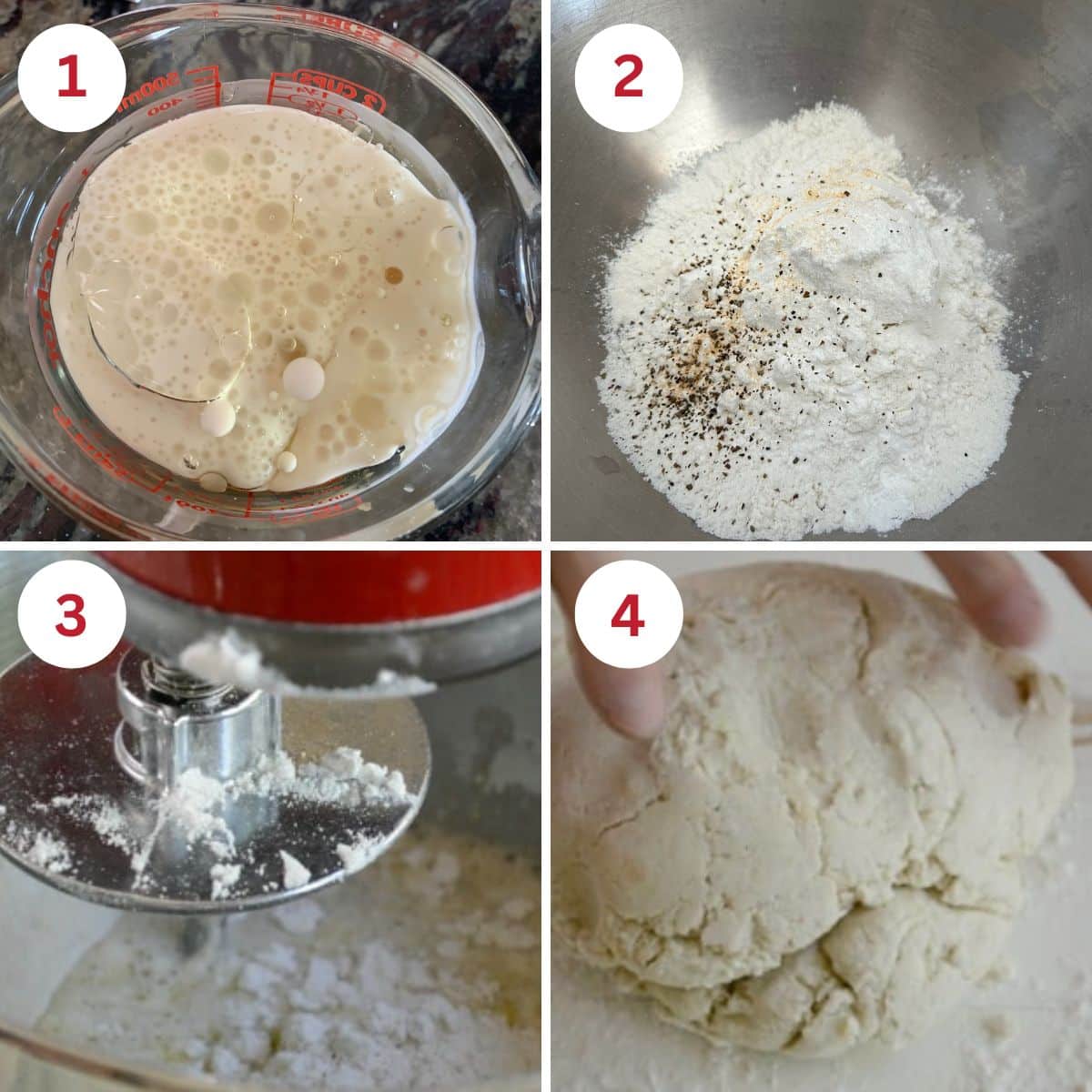
Step 1: Add the yeast and sugar to warm purified water to proof your yeast. Be sure to use water no hotter than 110°F, as it will kill your yeast. Purified water is best because chlorine and other chemicals in the water can kill the yeast. Let the yeast sit until the mixture is frothy and full of bubbles; you want this yeast mixture to get nice and foamy. This helps the pizza crust rise, making it less dense.
Step 2: You can mix this gluten-free pizza dough in a large
Step 3: Add the rest of the wet ingredients to the yeast mixture. Pour it into the stand mixer. Add the dry ingredients and mix on low.
Step 4: Remove the dough from the mixer bowl and put it onto a flour-dusted silicone mat.
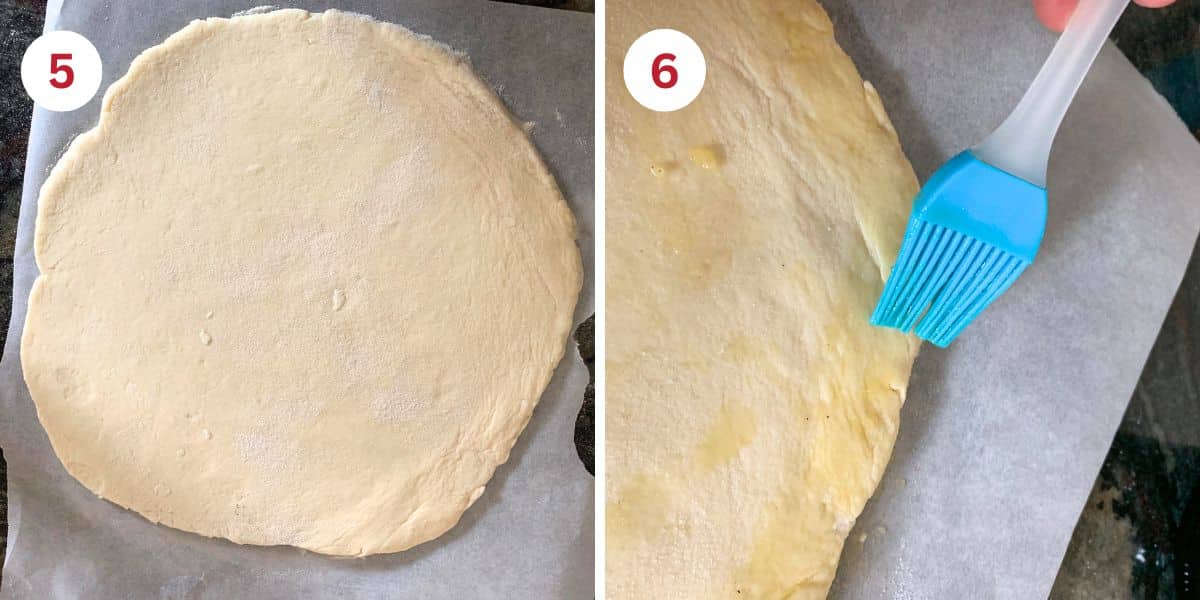
Step 5: Roll to your desired thickness. I roll mine to 1/4 inches, which works well for a medium crust. Cover the crust with plastic wrap and let it rise for 30-45 minutes.
Step 6: Brush olive oil over the edge of the crust. This will help your crust bake with a beautiful golden finish.
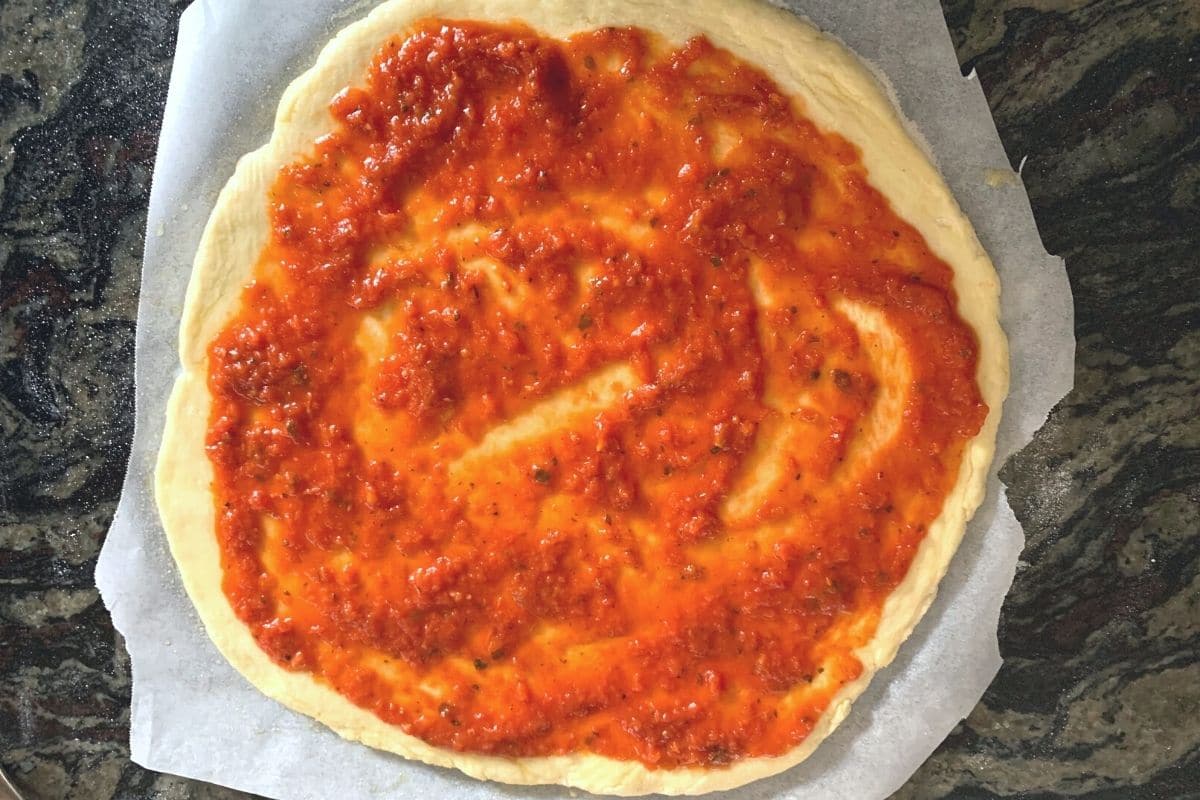
Email This Recipe To Me!
Step 7: Add the sauce, cheese, and pizza toppings.
Pizza Topping Ideas:
- Pepperoni
- Sausage
- Pineapple
- Ham
- Fresh basil
- Mushrooms
Gluten-Free Pizza Sauce Recipes:
- Use this easy homemade Gluten-Free Pizza Sauce recipe for a traditional pizza sauce.
- If you want a white pizza, use this Gluten-Free Alfredo Sauce to top your gluten free pizza crust.
- You will also have fun using this Nut-Free Pesto Sauce for your pizza.
How to Bake Gluten-Free Pizza Dough in the Oven:
If you’re baking your pizza crust, preheat the oven to 425°F. At this point, your dough should feel soft but not sticky. Spread the sauce onto the gluten-free pizza dough, add the cheese, and then top with your favorite toppings. Bake the gluten-free pizza for about 12 minutes until the cheese is slightly golden and melted.
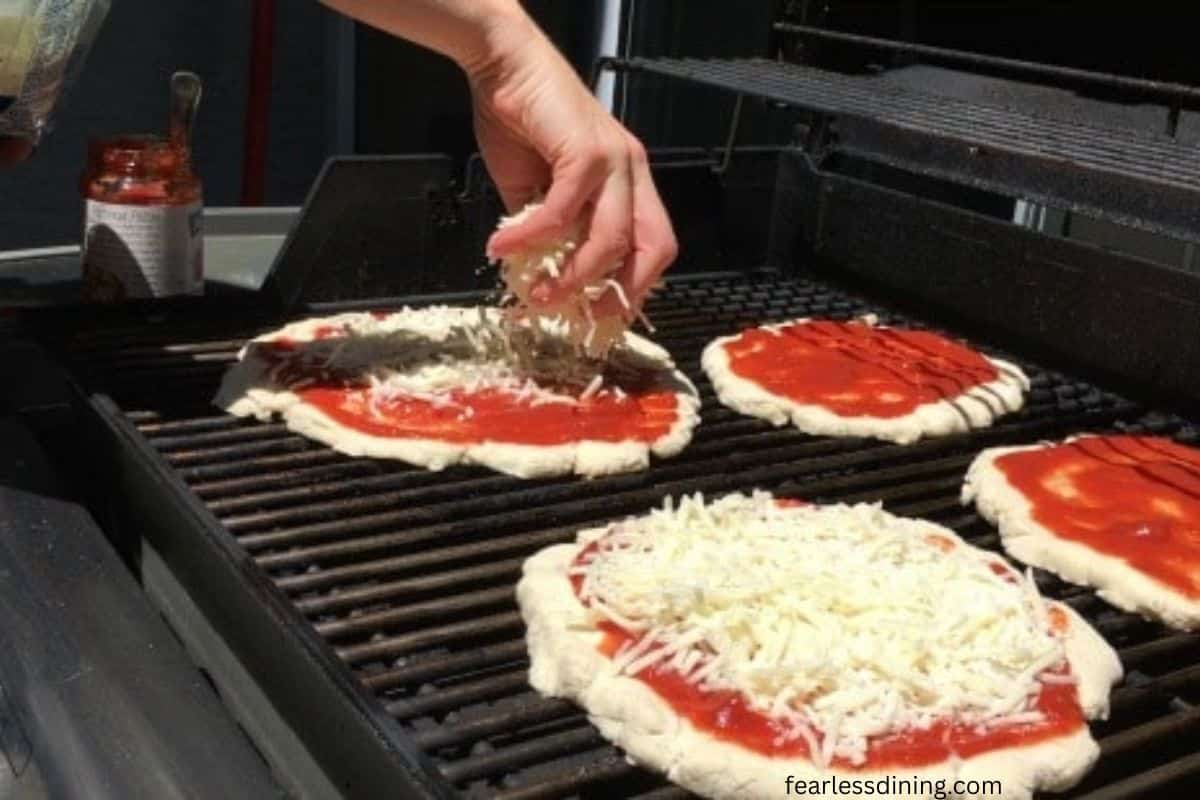
How To Cook Gluten-Free Pizza on the Grill:
If you choose to cook this gluten-free pizza dough on the grill, consider making personal-sized pizzas, as the dough is easier to transport and place flat on the grill. Place the pizzas on the grill and add your sauce, cheese, and toppings. Close the lid and cook at 425°F on the grill until the cheese is completely melted, about 8-10 minutes, depending on the thickness of the crust.
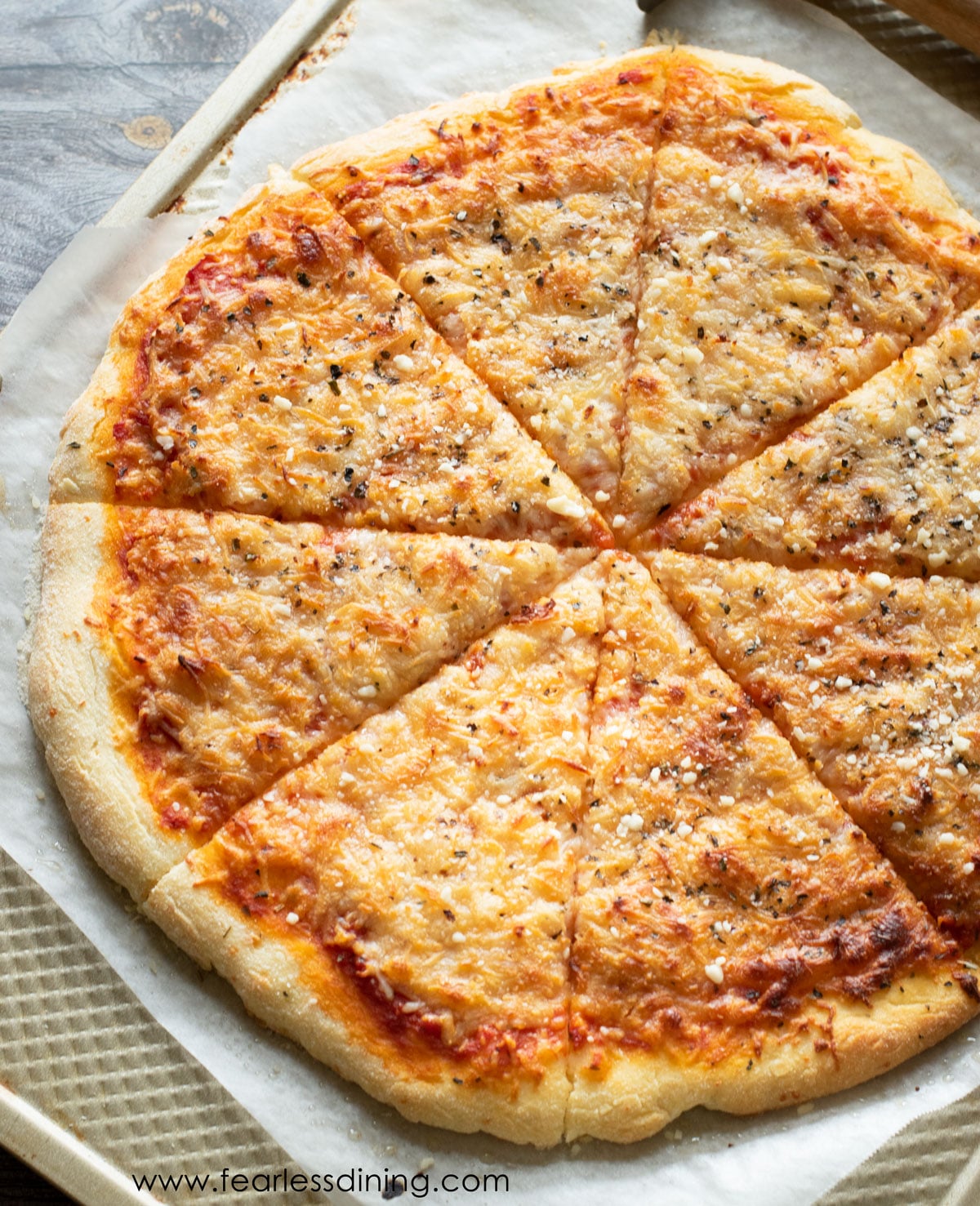
Storage, Freezing, and Make-Ahead Tips:
- Store the leftover pizza in an airtight container in the refrigerator. It will keep fresh for up to 3 days.
- You can prepare the dough ahead of time and store it in an airtight container in the refrigerator. Use it within 2 days.
- Freeze leftover pizza in a freezer-safe airtight container or zipper bag.
- Freeze the gluten-free pizza dough in an airtight freezer-safe zipper bag. Thaw to room temperature before using.
Frequently Asked Questions:
Unfortunately, you do need yeast for this specific pizza recipe. I do share a delicious yeast-free gluten-free pizza dough recipe above.
Nope…you don’t need a pizza stone to make my grilled pizza recipe. You can plop that raw pizza crust dough right on the grill! If you do bake this recipe in the oven, a pizza stone will help your crust get nice and crisp.
If your pizza dough is wet, it’s possible that you used a gluten-free flour blend that I haven’t tested. No worries. If the dough is too wet, add more flour until the crust dough is workable and can be rolled. If your pizza dough is dry, add 1-2 tablespoons of additional water. Every gluten-free flour blend behaves differently and has different moisture needs.
Gluten-free baking is a lot like chemistry. I discuss extensively why they don’t work well in yeast recipes in my article on the Best Gluten-Free Flour Blends.
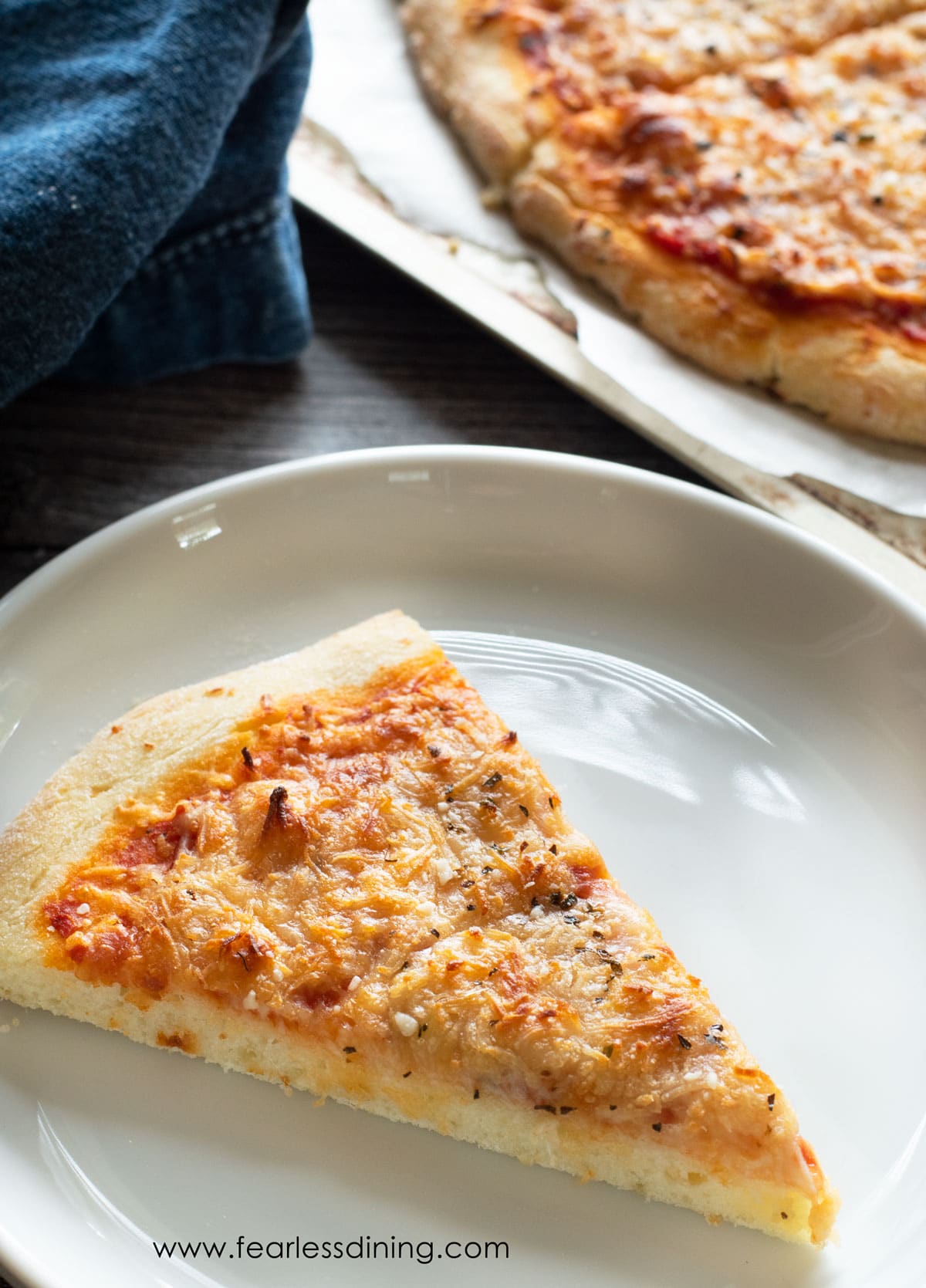
Sides to Serve With Pizza:
Love This Gluten-Free Pizza Crust Recipe?
💬 Did you make this recipe? Drop a comment and let me know how it turned out. Don’t forget to share the flour blend you used!⭐⭐⭐⭐⭐ Thank you!
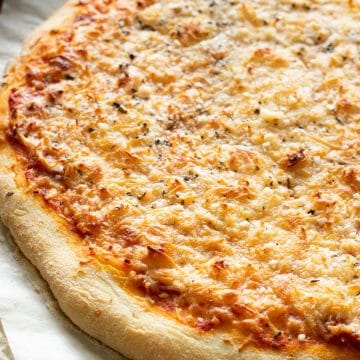
Gluten-Free Pizza Crust Base
Equipment
Ingredients
Yeast Mixture:
- 1 ¼ cup warm purified water
- 2 teaspoons active dry yeast * see note
- 1 teaspoon cane sugar or honey
Dough:
- 3 ½ cups gluten free flour blend * see note
- 1 ½ teaspoons salt
- ¼ cup grated parmesan cheese optional
- 2 large eggs
- ¼ cup olive oil
Toppings:
- 2 cups mozzarella cheese
- 1 ¼ cups pizza sauce * see note
Email This Recipe To Me!
Instructions
- Put the warm, purified 1 1/4 cup warm purified water in a bowl with 1 teaspoon cane sugar. Add 2 teaspoons active dry yeast and allow it to sit for 5-10 minutes until it foams up. (Chlorine can kill yeast, so use filtered, purified water.)
- In a stand mixer, add the foamy yeast, 2 large eggs, and 1/4 cup olive oil. Whisk to blend.
- Add a paddle attachment. Add the 1 1/2 teaspoons salt and 1/4 cup grated parmesan cheese. Gradually add the 3 1/2 cups of flour. Mix slowly on low speed. Continue to mix the dough for 2 more minutes.
- Every gluten-free flour blend varies, so adjust the dough's moisture accordingly. If the dough is really wet, add more flour a little at a time. If the dough is too dry, add more water until it is softer. Dry, firm dough doesn't have room to rise.
- Remove the dough and place it on a parchment paper-lined cookie sheet. On a baking sheet, shape the pizza crust into the desired size(s). You only get one good rise in gluten-free, so I recommend shaping the crust before rising.
- Note: If you are grilling the crust, you need to make the crusts personal-sized. Large crusts don't hold up as well to grilling.
- Cover the unbaked crust(s) with plastic wrap and let it rise 30-45 minutes.
- Remove the plastic wrap carefully.
Grilling Instructions:
- Preheat your grill to 425º F.
- Put the dough onto the grill and close the lid so the dough can cook for 3-5 minutes.
- Open the lid. Add sauce, cheese and your favorite toppings.
- Grill until the cheese is melted and the crust looks cooked. Make sure you check the bottom of the crust periodically to ensure it doesn’t burn.
Oven Instructions:
- Preheat the oven to 425º F.
- Heat a pizza stone if you are using one in the oven. If not, this pizza bakes great without a baking stone, so skip this step.
- Place your pizza crust on the pizza stone or a baking sheet.
- Add the sauce, cheese, and toppings.
- Bake the pizza for 12-15 minutes depending on crust thickness.
Video
Notes
- I have tested this recipe with Cup4Cup and Bob’s Red Mill 1 to 1 GF blend. Bob’s 1:1 was tested, but it didn’t perform well. Many 1:1 flour blends do not work well with yeast. Reader Tested: Pillsbury GF Flour and Better Batter.
- If your gluten free flour blend does not contain a binder, add 1 teaspoon of Xanthan Gum.
- This pizza will keep up to 3 days in an airtight container.
- If you want to make this pizza dairy-free, omit the parmesan cheese and use a dairy-free cheese.
- Yeast – double-check that the brand you use is gluten-free. Red Star Platinum is not gluten-free.
Topping ideas:
- Pepperoni
- Sausage
- Pineapple
- Ham
- Fresh basil
- Mushrooms
Sauce ideas:
- Use this easy homemade Gluten-Free Pizza Sauce recipe for a traditional pizza sauce.
- If you want a white pizza, use this Gluten-Free Alfredo Sauce to top your gluten free pizza crust.
- You will also have fun using this Nut-Free Pesto Sauce for your pizza.
SPECIAL NOTE
Please know that every gluten free flour blend has a different starch to grain ratio. If you use a blend I didn’t test, my rule of thumb is to add more flour if your dough or batter is wet and add more liquid if the dough or batter is too dry!
Nutrition
Nutrition Disclaimer
Nutritional information is an estimate provided to you as a courtesy. You should calculate the actual nutritional information with the products and brands you are using with your preferred nutritional calculator.
I truly hope you enjoy this recipe. I have been testing and creating gluten-free recipes for over 15 years. Creating gluten-free recipes that do not taste gluten-free is my goal for every recipe. Sometimes I only have to test a new recipe a couple of times, and others it takes multiple times. I do this so you get reliable, delicious results every time!


Can you freeze some dough for later?
Hi Sharon, I haven’t tested freezing it, but I believe a couple of my readers do well freezing it.
The dough was a little dry with my gluten-free flour mix, but I added 2 eggs and it turned out perfectly. Thank you so much, Sandi!
I am so glad you loved the recipe. Every flour blend is different, so I am glad you were able to add more moisture.
Thank you for your delicious recipes, especially the cookies.
This will be my first time trying gf pizza dough.
Can you prebake the pizza shell and bake at a later time?
Hi Carmella, I am so glad you are enjoying my recipes. I see no reason why prebaking and then baking would be an issue, but you will want to make sure the crust doesn’t burn when you add and bake with the toppings. You may consider partially prebaking it instead of fully baking it before adding toppings.
Can this dough be made ahead of time and frozen?
Hi Tessa, Yes, it can. I have a whole section on how to make it ahead in the post. You can find it easily if you use the table of contents to jump to that section.
Will high altitude affect this recipe? I live in NM and prior to going GF, some recipes have to be changed due to our high altitude here. I am new to GF so I am just starting to try new flour blends. Any insight on the different altitudes will be helpful. Our altitude is 5290′.
Hi Suzanne, I have no experience with high altitude baking. I asked my readers a year ago and I sort of combined all of their tips: My cakes and cookies need to be baked at 375 not 350. What works best where I am is the 25/25 method. Bake at 25 degrees higher than the recipe – this helps the outside cook faster as it rises and the middle won’t sink in later. Also, bake for 20-25minutes less. Depending on what you’re making you can also add a little extra flour or baking soda. But for baked goods like cakes, muffins etc I add a little extra liquid and usually an extra egg and I cut back a little on baking powder or soda (so if it says 1 1/2 tsp baking soda I’ll do 1 tsp). I also bake at a slightly higher temperature so instead of 350F I’ll do 370F for the first part then drop it back down to 350F.
This is my go-to pizza crust! We love it! I use Bob’s Red Mill 1-to-1 Baking mix!
That mix works really well. I am glad you loved this crust, Amanda!
I made it and the dough was super soft…so soft that it would not form a ball. I added more flour, and I could not get the ball to form. It was a sticky mess. I followed your recipe EXACTLY and used the Cup 4 Cup flour. Has this happened to anyone else? What’s the fix?
Hi Carrie, I usually use Cup4Cup and I see you used the exact recipe without subbing ingredients. Do you store your flour in the fridge? Humidity can affect the moisture absorbed. I would add 3-4 TBSP of additional flour or reduce the liquid to see if this helps.
I had the same problem. I had to add another 1 whole cup for it to form a ball and then the dough was too dense and didn’t turn out well. I used the same flour she lists and triple checked the recipe to see if I measured something wrong. I didn’t. Was pretty disappointing with gf flour not being cheap to use but I’ve had gf crusts that taste worst. This doesn’t taste bad, just didn’t turn out like it should have.
Hi Janelle, I am sorry this happened. Which gluten-free flour blend did you use? I tested several, so I need to know the specific flour blend you used in order to help troubleshoot.
I haven’t tried this yet but it looks good…I love yiur bread maker reciepe it is spot on and the first I’ve tried that doesn’t taste like cardboard…my question is can this pizza crust be made and frozen and then thawed out when needed….???
Thank you so much, Jason. i am so glad you loved the bread. You can definitely freeze this pizza crusts dough. I haven’t frozen it as a baked pizza though.
Can I still make this pizza crust if I don’t have a special mixer with a dough hook?
Hi Mary, you can easily mix this dough by hand. No mixer is needed :-).
The pizza was delicious but the crust was very soft and not chewy. I tried to roll it as thin as I could and cooked it in the oven, not grill. I used the Bobs Red Mill flour in the red package and had to add a lot more flour because the dough was still wet and sticky after 3.5 cups. I used a hand mixer so I’m not sure if I should have done something differently. Is this crust supposed to be soft or more chewy?
Hi Joan, I haven’t tested that flour but I do wonder if it is the bean flour that is in the Bob’s All Purpose Flour (red package.) My crust gets the chewy texture, but it only gets really crispy using a very hot pizza stone or cooking it on the grill.
Have not tried your recipe just yet, as I am a bit perplexed. You write that B.Red Mill 1-1 blend will not work well with yeast recipes but you later wrote in the recipe section itself that the recipe works well with Cup4Cup and the BRM 1-1. Please clarify. I love the BRM 1-1 but I also make a hack version of the Cup4Cup (works really well for recipes that I’ve baked with it). I just don’t want to waste ingredients, my time and effort, and then have another not-so-great or inedible pizza experience….
Hope you reply soon (today is July 20).
I discovered your site purely by chance and I an very pleased with what I’ve read thus far. Gracias.
BTW: I’ve had 10 yrs experience now with GF baking, and before having to embrace the GF lifestyle, I baked with regular flours, for total of 54 yrs of baking all sort of items, including pastries, breads, and even making pizzas, empanadas….etc…I just have yet to REALLY enjoy a GF pizza!
Hi Iris, I did test BRM 1:1 in the recipe because a few readers said it worked…but honestly, I don’t think it is a good choice. I will clarify this in the recipe.
Hello,
I was just wondering about flour amount for this recipe.
Under ingredients it states 3 1/2 cups of flour, but in the directions it states to add 3 cups of flour to the wet ingredients.
I assume 3 1/2 cups is correct?
Hi Jeff, Add 3 1/2 cups. I often add 3 then add the 1/2 cup in when I see how wet the dough is. It is hard because every gluten free flour blend has a different starch-to-grain ratio, and each needs a slightly different amount of flour. You should have dough that looks like the photos I share in the post. If your dough is wet, add more flour.
When you use the oven method do you partake the crust first? Or are you spreading the dough, topping it and baking all in go? Thanks!
Unless I am making something like cream pie, I just load the crust up and bake it with the fruit, etc.
This seems like a lot of flour for one pizza. Is the dough real thick? I haven’t tried it out yet.
Hi Lorinda, It makes a good sized pizza. You can definitely halve the recipe if needed.
Used my own flour blend and added an extra tip xanthan gum. Needed more flour for pressing into pan, but overall turned out well.
I am so glad you enjoyed the recipe. Every gluten free blend has a different grain to starch ratio. I am glad you added more flour, this is exactly what I do.
Best gluten Free Pizza crust I’ve ever had!! It’s amazing! I used Judees All Purpose flour and it came out perfect. Its the only dough that has ever worked for me and I’m so grateful because I love pizza.
I am so glad you loved the recipe, Louise. I haven’t heard of that brand of flour, but I am so glad it worked well!
After so many years of searching, trying recipes and being disappointed – this is the easiest to make and best tasting of any gluten free pizza crust that I have found. Thank you, thank you!
You made my day! I am so glad you loved this recipe.
Pizza dough works great for me and is flavorful. I made one pizza by prebaking the formed/risen dough for a few minutes and then adding sauce and cheese and finishing it off in the oven! Thank you!
I am really glad you love this pizza crust recipe. Thank you so much!
The pizza looks awesome! Can I just clarify – if I use your flour blend am I adding both 1 tsp of xanthan and psyllium husk? Or is the psyllium husk replacing the gum? Thanks 🙂
Hi Louise, if you are using my blend, there is no need to add xanthan gum. Just the additional psyllium husk.
I have tried alot of your recipes this was amazing I used your flour blend which is going to be my new flour blend love this ❤️
I am so glad you loved my new flour blend in this pizza. My husband told me I can no longer use store-bought blends after trying the new mix. Thank you!
Can the dough be refrigerated or frozen for later use?
Hi Kathie, How long do you want to refrigerate it? I would say not to let it stay in the fridge too long, but the next day should be fine.
Hi, I’ve tried many of your recipes and been satisfied with the results. I haven’t tried this recipe yet but I want to ask you to clarify your information concerning the Bob’s Red Mill flour acceptable for this recipe. In the wording prior to the recipe, you say you’ve tried Cup for Cup and Bob’s Red Mill all purpose GF flour blend and both work well. In that same paragraph you say not to use BRM 1 to 1 GF blend. Then in the notes after the recipe you say you’ve tried Cup for Cup and BRM 1 to 1 GF blend, but not the others. I think you want to say you’ve tried it with BRM all purpose GF blend in the notes and not the 1 to 1 GF blend.
Hi Jan, So I did test BRM 1:1…but it didn’t perform very well. I will clarify. Bob’s All Purpose and King Arthur All Purpose both did work in this recipe, but not as well as Cup4Cup. It is tricky to be sure. I just tested my pizza with my homemade blend, and my family liked it best out of every blend I have tested. Note you should read the bottom where I talk about the recipes I tested this blend in b/c the pizza did need a bit more liquid with this blend. https://www.fearlessdining.com/easy-gluten-free-all-purpose-flour-blend/
do I have to add guar gum if I am using your flour blend?
I am Nightshades – free so can I change to tapioca starch?
what is the amount of water needed?
can I use this blend in any gf flour recipe?
Hi, my DIY blend is gum-free and has psyllium, so you do not need to add xanthan gum. In theory, tapioca starch should work, but I haven’t tested it to be sure. As for this blend, I have a list of recipes I have tested it in at the bottom of the post.
In the ingredients next to yeast, it says see note yet I don’t see a note about yeast. Am I overlooking something?
Hi Kara, this is the info in the post. I added it to the recipe card. Yeast – double check the brand you use is gluten free. Red Star Platinum is NOT gluten free!
What if I only have instant yeast?
Hi Traci, it should work.
I’m so sad because my crust was a fail. After adding the 3.5 cups of cup4cup it was still liquid. I added more flour until it formed a dough. Rose it, shaped it, baked it. It was crumbly and didn’t hold up at all. Any ideas? Pretty sure I followed directions exactly. Thanks!
Hi Abi, gluten-free flour only gets one rise, so if you rose it and then shaped it as you mentioned above, you pushed all from the first rise air out. As for needing more flour, you do need some flour to dust the top of the crust…but I haven’t heard about the mixture being liquid after 3.5 cups. Is there any way you didn’t measure the flour or liquid ingredients correctly or doubled up on liquid?
Hello!
My mom eats gluten-free and loves pizza crust but every brand of frozen gluten free pizza she gets, the crust is so thin and crispy and she just wants a nice fluffy and chewy pizza crust! I want to make this for her (make the dough and assemble it with the sauce and toppings) and wrap it up in-baked and have her bake it herself. Would this recipe work for doing that?
Thank you!
-Kaitlin
Yes, you could bring her the dough to bake herself. This crust is fluffy (if you use flour like Cup4Cup that rises well.)
This pizza crust was awesome!! I used the Pillsbury Gluten free flour and it worked great and I used Bella yeast and this was so delicious!!
I am so glad to hear that the Pillsbury gluten free blend works so well in this recipe. Thank you so much for coming back to let me know!
Can I make this a day ahead and leave the ball of dough in the fridge? And then form the personal pizzas the next day? Or should I finish the whole recipe and have the 4 small pizzas all ready to go?
Hi Stephanie, you can make this a day ahead. Know that gluten free dough really only gets one good rise, so your crust may be a little less fluffy if you rise the dough then shape it.
Can you cook and freeze for later?
Hi Karen, I have frozen the dough, but I have not tested freezing a baked pizza crust. If you try it, please do come back and let us know how it worked.
I’m wondering if this crust can be made and frozen for use later. We are taking a trip and part of the meal prep for me involves making and freezing some essentials such as pie crusts, cooked chicken breasts, homemade sauces, etc. This way cooking is easier and I don’t have to worry about finding healthy stuff in a new town. Thanks in advance.
Hi Lisa, It should be fine to freeze and thaw the dough. Keep in mind you may want to dust a little flour when it is thawed so the yeast have some thing to feed it.
Very good crust. Has a nice chewy texture. I normally shape & bake pizza crust for 7-10 min, then flip & add toppings so the crust doesn’t stay soggy, (I like a lot of toppings). I tried it as stated & turned out fine. One of my favorite sauce/toppings is to cube or shred cooked chicken breast or thighs & coat with a mix of 1 cup BBQ sauce & 1/4 cup tomato paste. I add sauteed onion & sliced black olives too.
I am so glad you enjoyed the crust Darilyn. I haven’t thought about flipping the crust midway through baking (before toppings) but I bet it works well for getting it crisp!
I can’t wait to try this recipe! It looks fantastic!
How far ahead of time can you make this dough? And would you mix the dough, place in refrigerator or freezer, and then take it out and let it sit/rise for an hour? Or let it rise first and then refrigerate or freeze?
Hi Kerry, I have made it ahead and stored it in the refrigerator about 24 hours. It can rise in the refrigerator overnight if that is easiest. I haven’t tested freezing it, but I am sure it will freeze well if you wrap it in plastic wrap, then place it in a freezer safe zip baggie.
Oh yeah, I can’t wait to try this, it looks wonderful. I was ‘famous’ for my grilled pizzas before becoming GF and I’ve been trying to recreate it with a GF pizza crust. This is definitely going on my menu this weekend. There is nothing like a good grilled pizza. The only thing I used to do differently is to flip the pizza crust half way through the cooking time, then add the toppings and close the lid to finish cooking and allow the cheese to melt. Will let you know how it turns out – THANK YOU!!!
You are the second person to say flip the crust. I need to try that. Please let me know how that works. Thank you so much!!